Unless their 15-point penalty for illicit transfer activity is reversed on appeal, it seems more improbable that Juventus will play in the Champions League after they struck the woodwork three times on a dismal night in Rome.
Despite being docked points, Massimiliano Allegri has done a fine job as manager. The addition of Paul Pogba to the team may prove to be the fulcrum around which all other difficulties may rest.
On the other hand, it was an oddly triumphant week for Juventus’ opponents after a rather embarrassing defeat in Cremona on Tuesday. Then, even though the U-14 Roma team was losing to Lazio, José Mourinho still went to the game to encourage the players. To everyone’s eyes, it seemed like a typical Mourinho performance. In addition, the young guns got to meet the stars of the first squad, which was a dream come true for the ambitious teens.
The Portuguese coach is not known for his team’s flair on the field, thus the first half was a somewhat drab affair. Yet, if not for a brilliant stop by Juve goalkeeper Rui Patricio, Juve would have gone into the break with the lead thanks to a close-range header from Adrien Rabiot.
Cremonese, on the other hand, has given Mourinho consecutive defeats and is now mired in last place. The team’s confidence was boosted after progressing in the Coppa Italia, and they went on to win their first league game the season. Mourinho’s mind has been awakened by the defeat to Cremonese, and he must now include it into his tactics.
How Roma overcame adversity at home to defeat the Bianconeri will be dissected in this tactical analysis. As part of this analysis, we will also consider the steps Mourinho has taken to improve the team’s performance after their loss to Cremonese.
Lineups
Mourinho used his third preferred formation, a 3-4-3 that he has played around 16% of the time this season. Three defenders began in front of former Wolverhampton Wanderers goalkeeper Rui Patrício.
Chris Smalling, a former Manchester United defender, began the game as the centre-back between Roger Ibañez and Gianluca Mancini, who scored the game-winning goal. Fullbacks Leonardo Spinazzola and Nicola Zalewski were responsible for covering the flanks.
Just in front of the centre backs, Nemanja Matić and Bryan Cristante played as a double pivot. It was decided that Lorenzo Pellegrini would start up front with Gini Wijnaldum and the Argentinian Paulo Dybala.
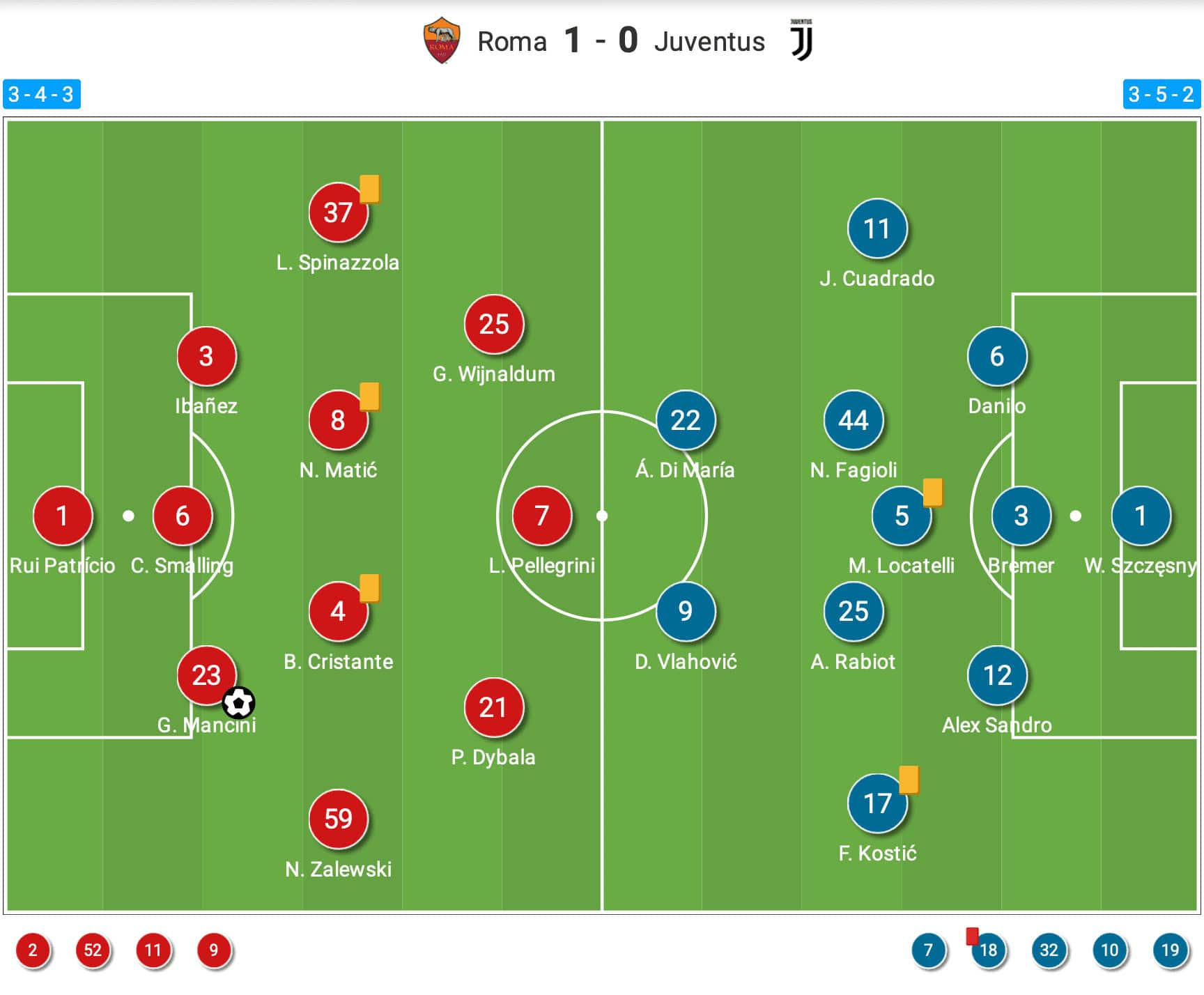
Allegri resorted to the 3-5-2 formation he’s employed as much as 25% of the time this season. With the three Brazilians at the back, the team opened with former Arsenal goalkeeper Wojciech Szczęsny.
Juan Cuadrado and Filip Kostić played the outside back positions, while Danilo, a former Real Madrid player, was one of three central defenders with Bremer and Alex Sandro.
Beginning in the middle of the field with the starting eleven were Nicolò Fagioli, Manuel Locatelli, and Adrien Rabiot. Right and left forward, respectively, for the game were Dušan Vlahović and World Cup hero Ángel di María.
Why Juve could not capitalise despite all-night attacking
As the home team struggled to stop Juve’s advances, they did start making clearances that added up to 24, while Juve only had 12. Mourinho has always had a reputation for being aggressive, which is necessary in football. One situation when a manager could use overt aggressiveness is at a press.
Nevertheless, in contrast, Roma’s pressure never got going. The plan was to take a defensive stance and let Juve come at them. The passes allowed per defensive action (PPDA) is an important indicator of how much effort teams put into pressing.
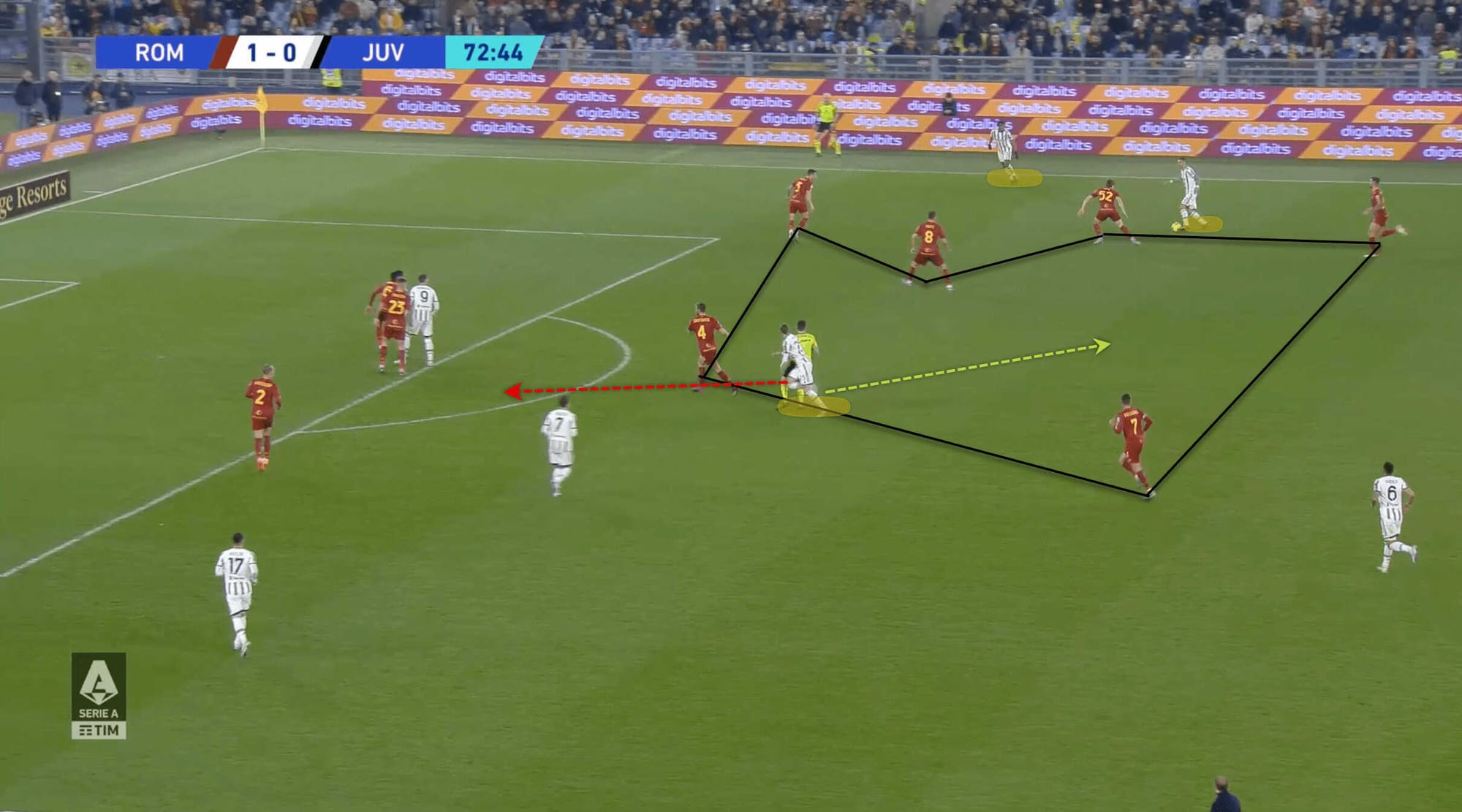
Di Maria and Cuadrado in the above shot are in a 3v2 scenario on the right side of the field late in the game. Rabiot notices it, but if the cross is played, he opts to proceed to it instead.
He might have supported and shaken Roma’s structure by getting close to their playmaker and then trying to penetrate. Having faith in crosses is great, but making crosses your top priority might have unintended consequences.
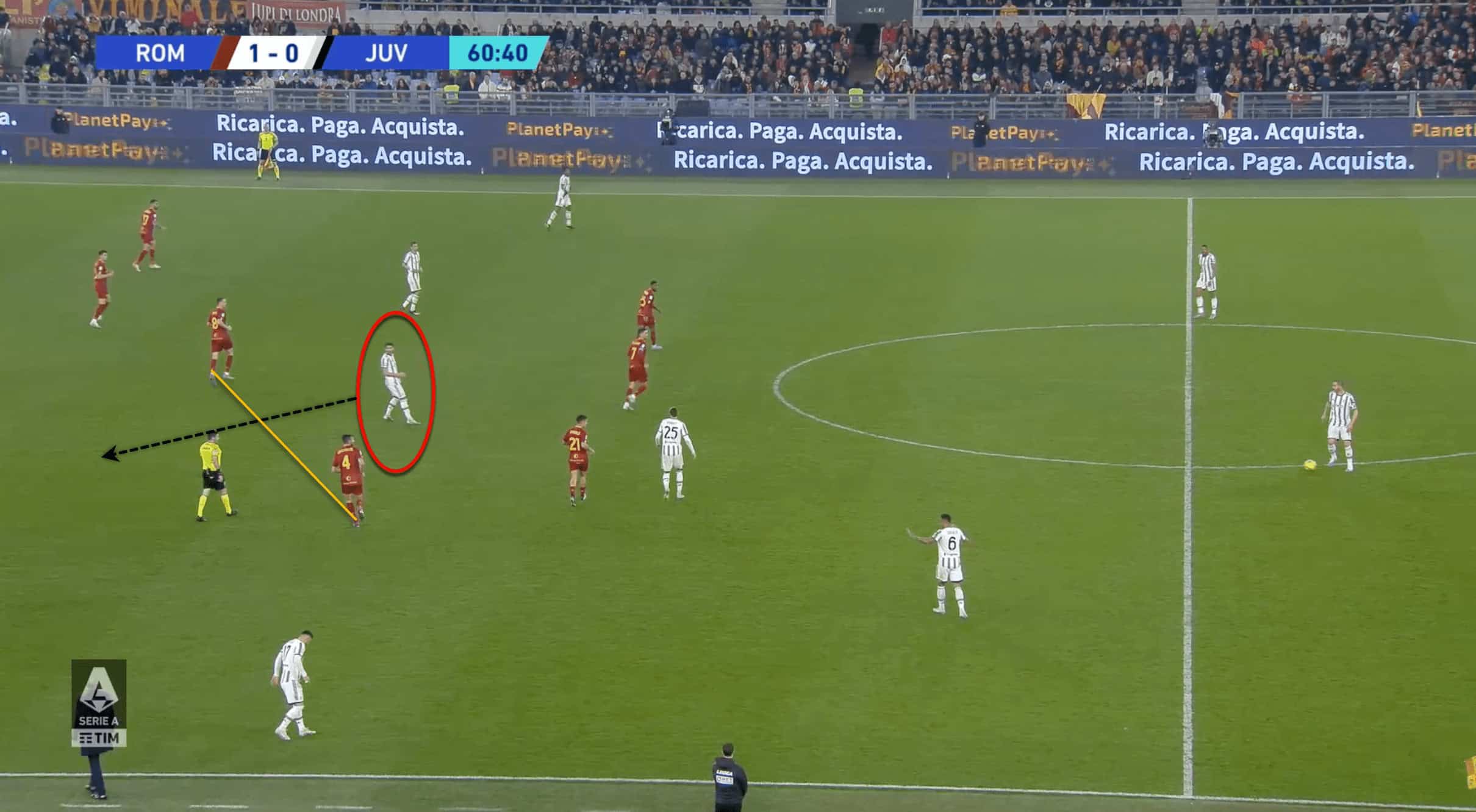
Roma’s opponent was under no pressure to do anything other than watch them play since they permitted 16.32 passes before a defensive action was taken. The 9.82 PPDA that Juve managed against the league’s top five teams is respectable.
The above screenshot was stopped at the moment when Locatelli, the central defender, saw the open area beyond the midfield.
He looks over his shoulder to see whether the pass is clear, and then he slips behind his marker. This gave him the opportunity to play together with his mates after taking a touch. None of the midfielders, who link the defence and offence, had this behaviour.
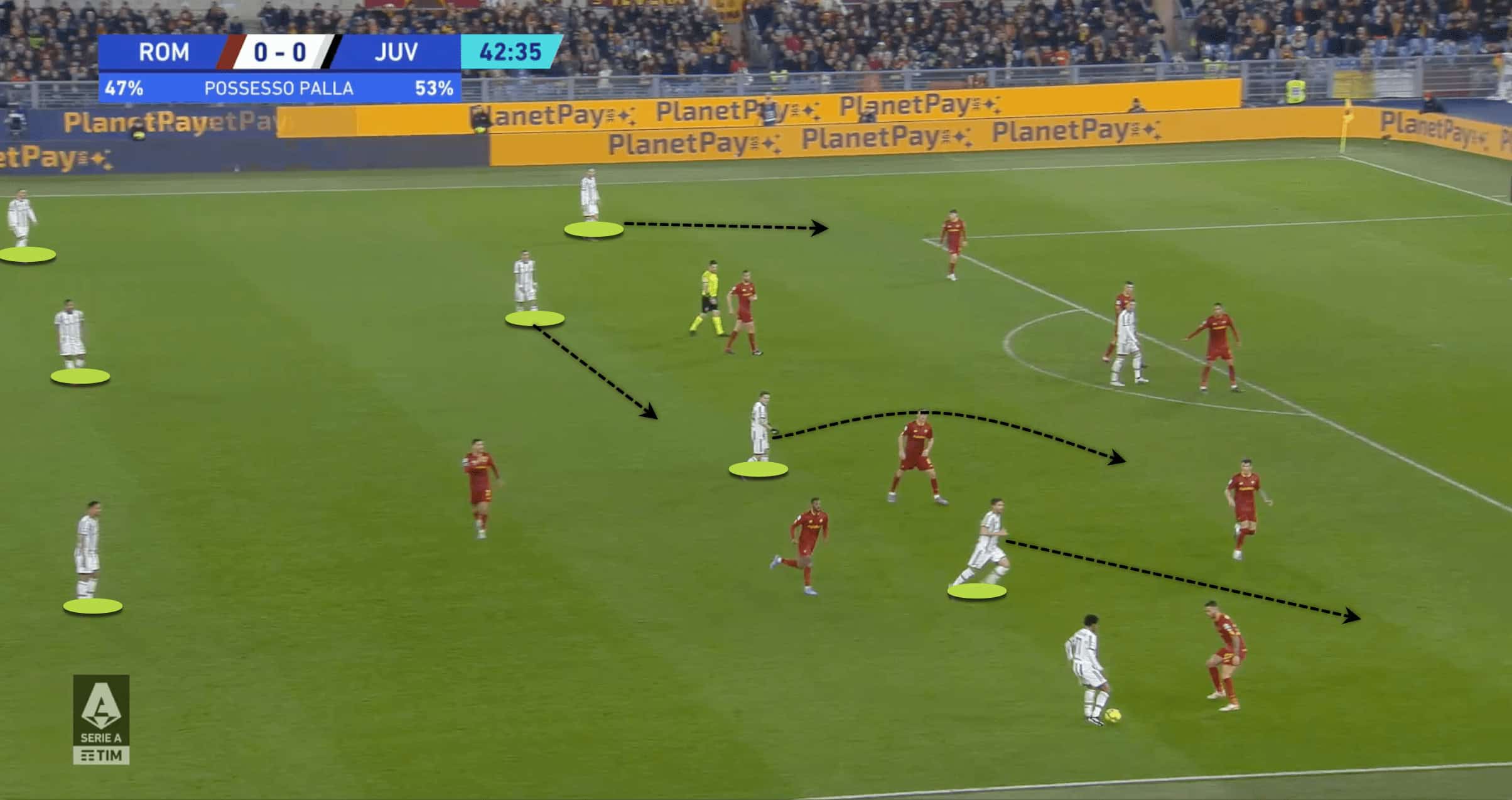
When the stalled structure couldn’t break through the five-man Roman defence, Juve had to suspend its plans. They lacked the tenacity to persist in their pursuits and maintain their positions.
Manchester City, coached by Pep Guardiola, constantly changes its formation and personnel in search of the best possible pass or run. Instead, we observe the Bianconeri just standing in their allotted place.
The number of passes completed by Juve in the final third was 64, with an incredible 52 of those passes being successful. Rome was limited to only 29 passes, of which only 19 were complete.
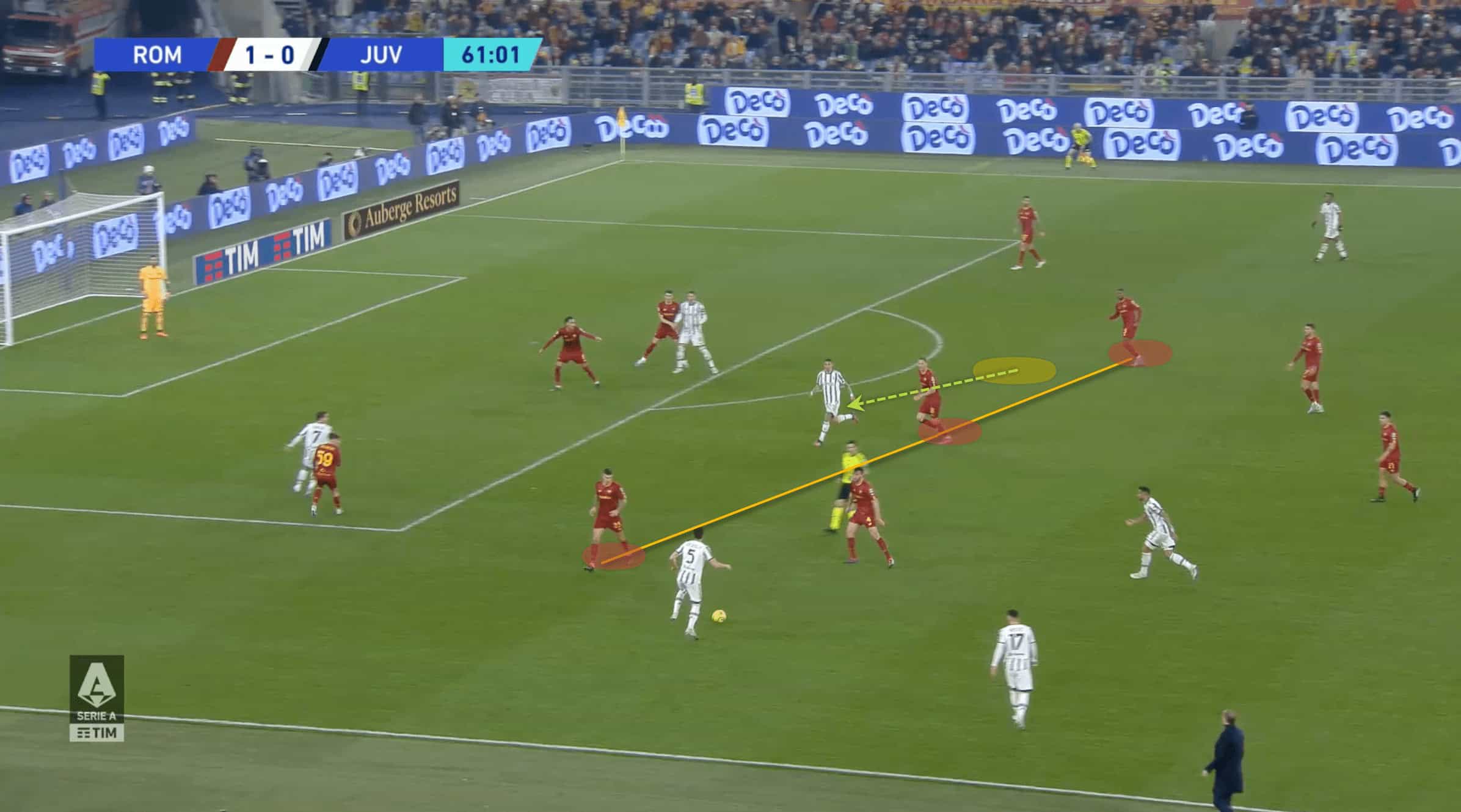
Di Maria came inside and positioned himself behind his marker while Locatelli went to the wide regions to collect passes (as shown in the above shot).
He avoids being seen by his marker by sneaking around the back and entering via Locatelli’s unguarded door. The rest of the squad missed this pattern of behaviour that was evident to the Argentine veteran.
In regards to progressive passing, Juve had 85% accuracy whereas Roma only managed 62%. The numbers say a lot about how fast things were moving and which team ultimately won.
Juve were hampered since crossing was their only option because they failed to make effective use of the half-spaces. The team’s lone playmaker/ball distributor, Di Maria, was not paired up with a suitable central midfielder.
Why Roma’s attacks did not possess much threat
As a result of their uninspiring offensive strategy, Roma did not have many viable possibilities for scoring. Overlapping and underlapping by the fullbacks, as well as player movement in the shallows, were not visible.
When Spinazzola had his time limited once, he received good but not outstanding support. As the actual fullback is on the inside, it is up to the winger or the central midfielder to cover and create space for the ball carrier.
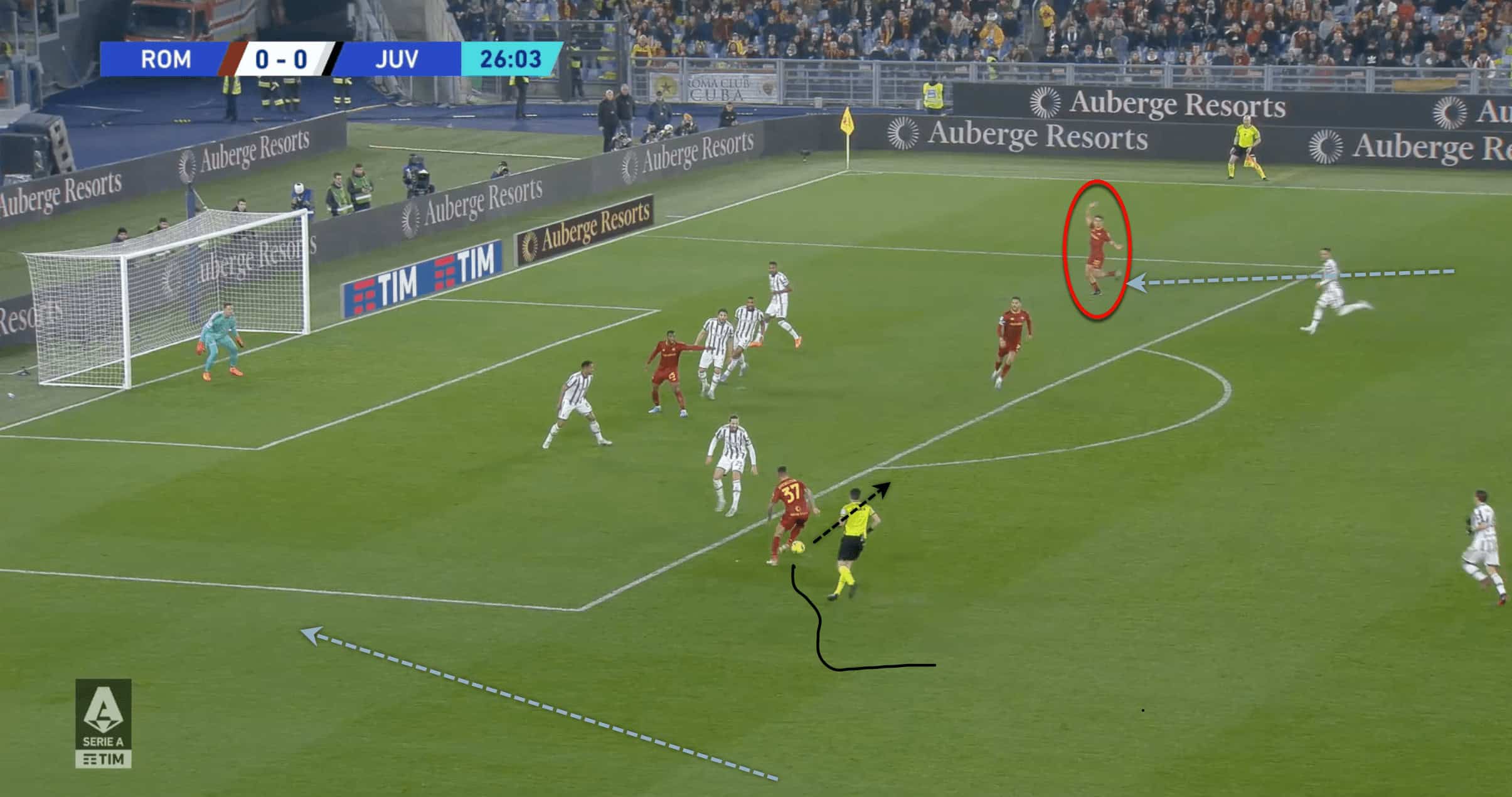
The fact that Spinazzola fails to see Dybala approaching is inexcusable. Being a left-footer, he is used to taking advantage of such opportunities, so a low cross or ball to his feet would be ideal.
Roma’s 0.13 xG and Juve’s 0.98 xG don’t make any sense in light of the final outcome.
In the early minutes of the second half, Juve got themselves into a terrible defensive scenario, with Dybala having the ball at his feet and the five-man defence utterly crumbling.
Zalewski, Roma’s youthful right back, is always on the lookout for a through pass that will allow him to get behind the opposition’s defence and play a cross or attempt a shot from deep.
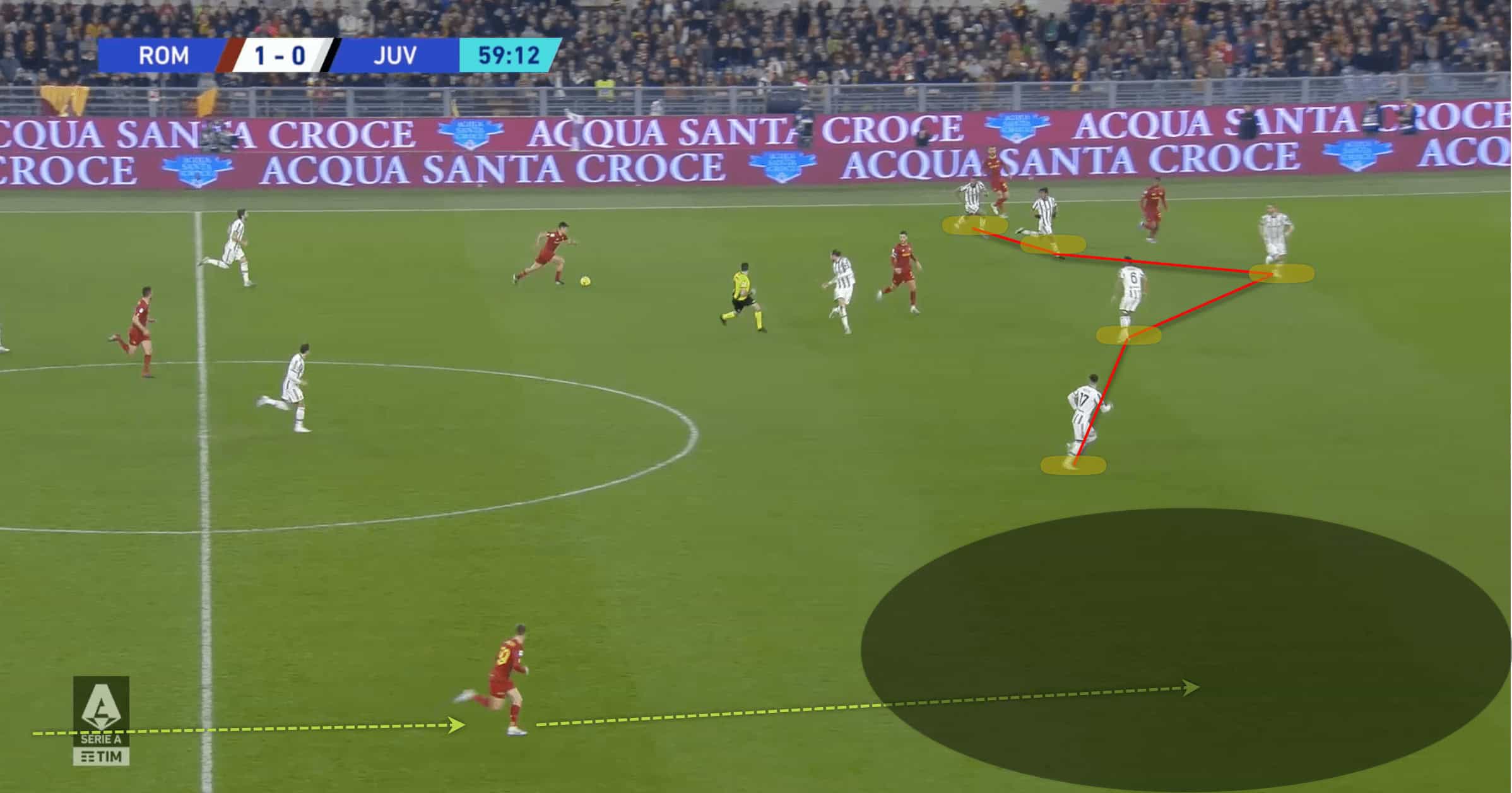
A ball to Dybala’s left made it simpler for Juve to defend, but he failed to see the rushing right-back and instead sent it to the left. Hence, there was no cause for alarm among Juve’s management.
Zalewski was facing up against Kostic one-on-one when he decided to cut in order to better assess his passing alternatives. He was obligated to return the ball to the unseen midfielder.
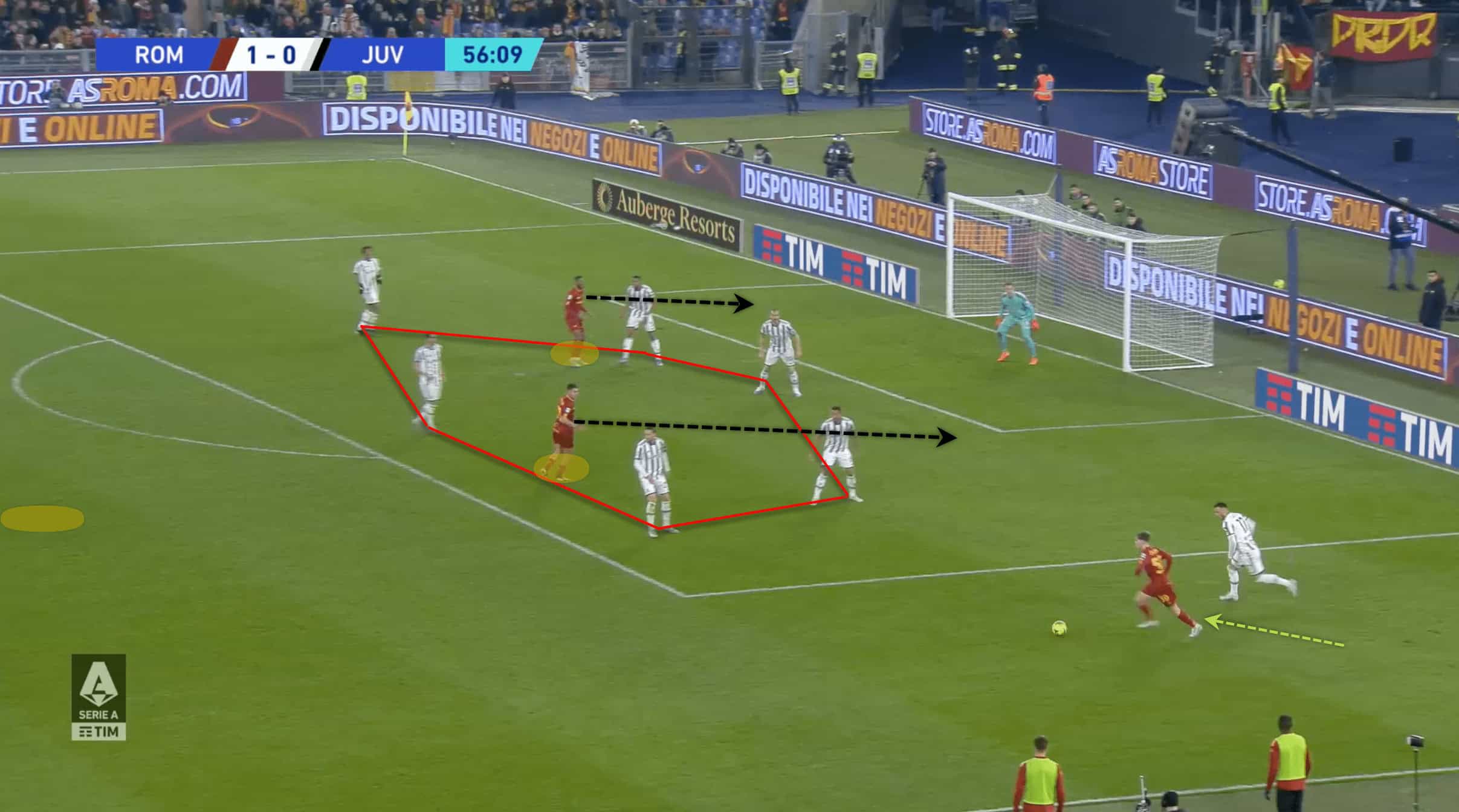
Similar to how Raheem Sterling did for Chelsea by moving into tight places to create passing lanes, Dybala’s movement may have altered the situation’s outcome.
Even though Roma’s set pieces didn’t provide any scoring opportunities, Juve’s efforts were thwarted twice by the crossbar.
Juve had six corners, two of which resulted in shots, compared to Roma’s two. The level of danger posed by Roma was minimal at best.
It’s shocking that Mourinho’s team let up no free kicks to Roma in that region. Juventus had four free kicks, and one of them resulted in a shot on goal.
Cremonese effect
In terms of chance generation and other statistics, this game has been somewhat similar to the one in Cremonese that took place immediately before it.
As Cremonese scored 0.87 xG, Roma only managed 0.76, giving Cremonese a little edge in the battle for the joint-worst point total in the top five leagues.
The double-pivot pair has been moved, and that is the only major change between the two sets. Against Juventus, Gini Wijnaldum paired Cristante alongside Matic at the beginning of the game.
Against the Bianconeri, Matic’s defensive posture and expertise as a true defensive midfielder were crucial.
Wijnaldum, who often takes the initiative, was caught off guard by Cremonese a few times. Since going up removes a player from the defensive unit, it is essential to assess the state of the game before determining whether or not to take advantage.
Gini’s mentality would be ideal for a club that presses and counterattacks often, as Liverpool did under Jürgen Klopp.
For example, Matic tends to hang back in order to provide the defence with more caution and awareness.
To him, it’s never a good idea to go up and try to link up with his mates in the final third. As a result, attacking for Juve became more laborious, while attacking for Cremonese became somewhat easier.
Gini joined the starting lineup in the second half against Cremonese, joining the captain Pellegrini in a front three. That way, there’s always a midfielder applying pressure when the team pushes.
As Cristante presses up front, Gini is often located far away from the area where the ball is about to be played. The defensive midfield was exposed because of his placement.
The concept of covering one’s duel didn’t appear to be present. Cremonese’s breakthrough should have been hampered by the swift communication necessary to cover his front-running teammate.
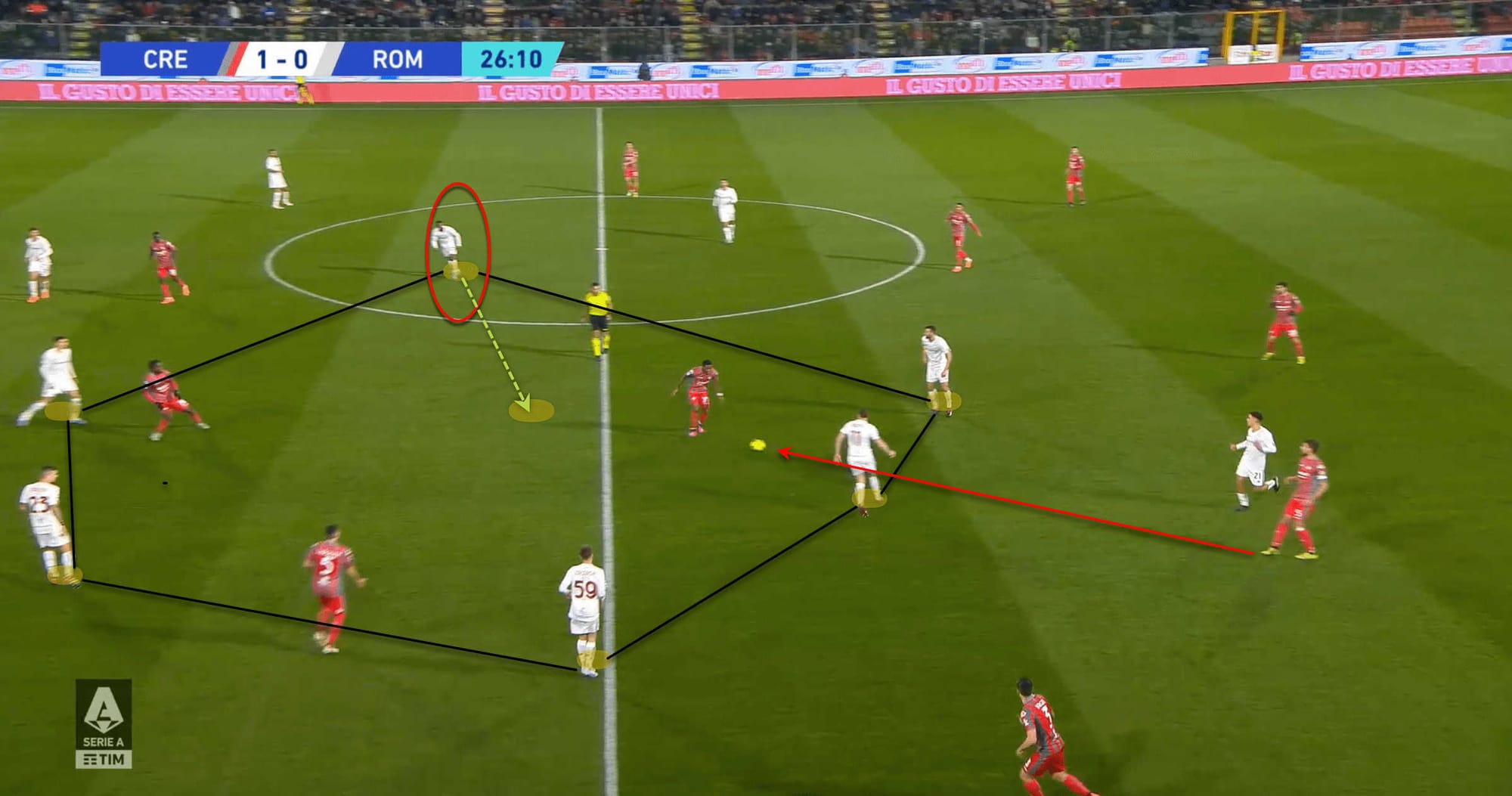
To penetrate and give the impression to the opposition that space is being exploited, little combinations in the centre of the field are crucial. Nonetheless, the interlinear spaces have been used seldom.
No player ever managed to pull off a first-time ground pass to set up a run or go through against either defence. Even Mourinho’s Spurs were built to break through the lines vertically.
During the match against Cremonese, Mourinho decided to start Andrea Belotti for Tammy Abraham in the starting lineup. As there wasn’t enough combination play, Abraham didn’t contribute much after coming in late.
Here, we see Abraham dropping like a false 9 between Dybala and El Shaarawy, creating almost three open players in the half spaces.
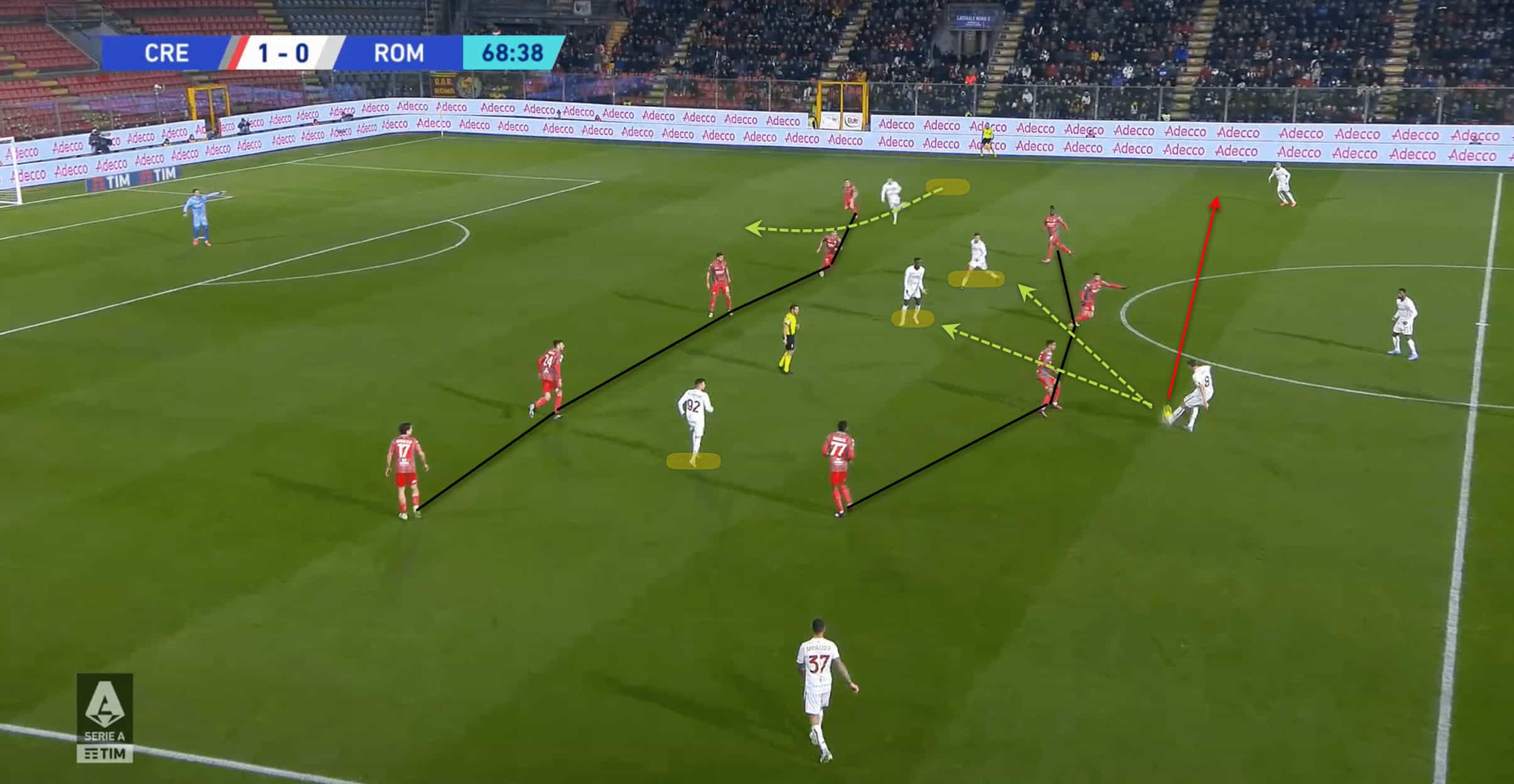
Matic, who also came in late, failed to see the passing opportunities to advance the ball vertically. Another player in the picture, a right winger, can be seen making a curling run to stay onside.
Except that Matic’s initial pass went to the right-back, which is marked red, everything else seems fine. Matic’s passing has been subpar when he has seen the winger’s run and the gap between the lines.
El Shaarawy is in a prime position to make things much more difficult for the opposition if the ball had gone to Dybala or Abraham.
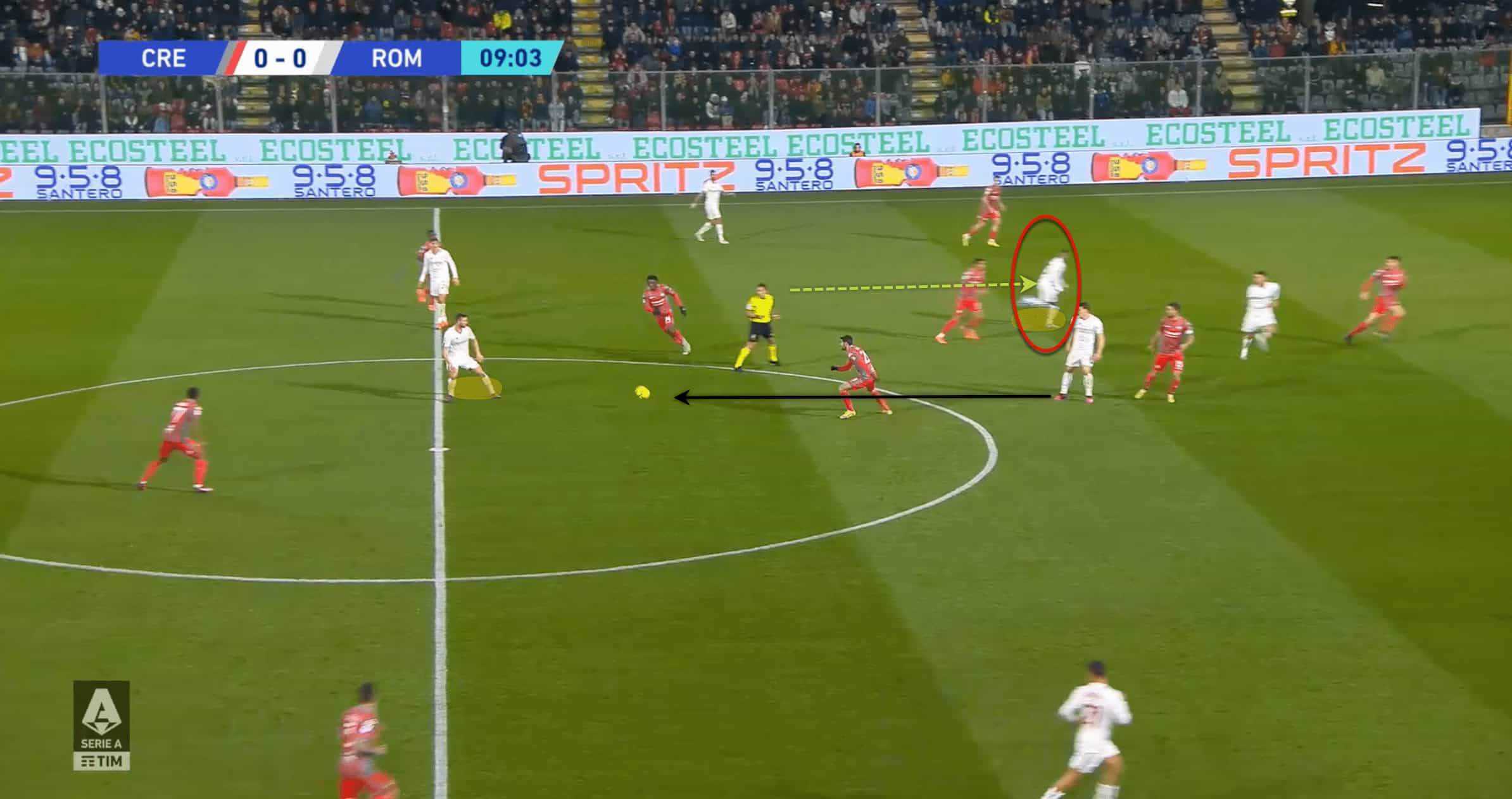
As the Cremonese apply pressure rapidly in the middle of the field, Gini will want a pass from Cristante in order to launch a deep attack.
There is movement at both axes, but they are out of phase with one another. Gini’s dynamism is crucial for a team that is having trouble getting on the offensive and making the proper passes in the final third.
Cristante, though, does not have time to notice it and instead makes a back pass. The scenario is the same as when the ball is selected; the double pivot is separated and may pose new complications.
A big difference between the two games can be traced back to Roma’s poor decision-making and the items that were addressed.
Conclusion
Juve had several opportunities to score and repeatedly broke through Roma’s defence, but they were unable to score one.
Compared to Juve’s 14, which is more than three times as many as Roma’s, Roma only managed to fire off 4 shots, just 2 of which were on target.
It was clear that Juve’s emotions were boiling up after they squandered a good chance to advance in the standings. Despite the financial missteps, the team looked to go on with optimism.





Comments